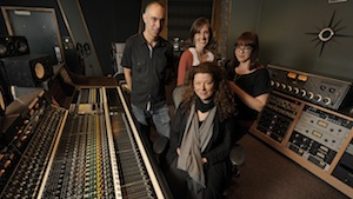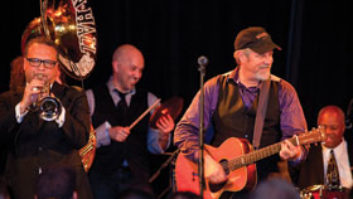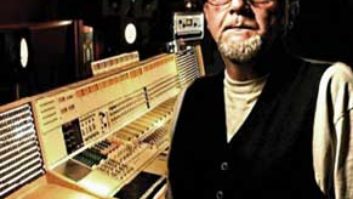
Justin Townes Earle
Nature or nurture? When he was growing up, Justin Townes Earle didn’t have a lot of time with his father, Steve Earle. Yet the son has a remarkable, fully formed talent, a rebellious streak a mile long and, already, a drug-darkened history at the under-ripe age of 26.
Earle’s Midnight at the Movies, his sophomore release for Bloodshot Records, is a near-perfect Americana album. The old-time instrumentation Earle favors is twisted just enough by his intense vocal and moody vibe — an approach encouraged by Earle’s co-producers, R.S. Field and Steve Poulton, both of whom also worked on Earle’s debut, The Good Life.
“I didn’t want it to be too much of a wax-museum thing,” says Field, whose credits include John Prine, John Mayall, Buddy Guy, Billy Joe Shaver, Todd Snider and many more. “We were not trying to be so reverent on this album with our anachronistic tones. I think we went for more ambience on the melodic choices and the instrumentation; we pulled back more veils on this one. It’s not quite as out-and-out rootsy in its approach; some of it is dreamier.”
Field and Poulton brought Earle and his band back to the same studio and engineers they’d used on Good Life. Recording almost entirely live in House of David (Nashville), the musicians were recorded by engineer Adam Bednarik — to Pro Tools HD, using Apogee AD16X converters — and mixed by Richard McLaurin on the studio’s 1970s API 2832 console.
Bednarik says that Earle was situated in a cubby-like space when they tracked the first album, but he moved out into the room for Midnight at the Movies. “He was out next to the piano and I built a little gobo house for him,” Bednarik explains. “We wanted things to sound a little more open and to have better sightlines to the band. On the first record, they had rehearsed everything and learned all the songs, but on this one they were coming in fresh and learning the songs in the studio, so it was good for Justin to be able to see everybody, give some looks and guide.”
Bednarik used a combination of tube and ribbon mics that he placed for room ambience, as well as close-up. “For Justin, I stereo-miked his acoustic guitar and he sang into a [Shure] SM7 to cut down on bleed. Then I used a 1073 as a mic pre, and went into an 1176 followed by an LA-3A. Since I knew it was going to be mixed on the API, I tried to use different outboard mic pre’s to complement it for the mix stage — a lot of Neve mic pre’s and some tube mic pre’s. There are some 1073s and 1272s and a [Vintech Audio] Dual 72. I tried to just get everything to sound really open and big and natural by working with mic placement and getting it to sound good on the front end.
“I ran some stuff through compressors,” Bednarik continues, “but not really to compress it — just for the sound. I also worked a lot with the low end, which is pretty huge on this record with the upright bass and the kick drum. I tried to get a really natural sound on everything, but also separate it so that the frequencies aren’t masking each other.”
“Adam always leaves me lots of room to do what I want when I mix,” McLaurin says. “Unless there’s something very specific they’re trying to do [during tracking], he doesn’t commit to some certain sound, which leaves me a lot of leeway for mixing.”
McLaurin says he could hear the “dreamier” approach to Midnight at the Movies when he received the basic tracks. “So I followed their lead,” he says. “I think the material dictated that, and so I tried to expand on that a little bit — keep it in that realm. We were working quickly, so we had to pull things up and go with our gut. I remember going between our plate reverb and my AKG stereo spring chamber — that tends to be a little dark and in keeping with what they wanted.”
McLaurin also used the LA-3A during mixing. “That was for the tone of it,” he says. “It tends to make whatever I was hearing with his voice, only more-so.”
The mains at House of David are Dynaudio M2s, but Bednarik and McLaurin both do most of their monitoring on Yamaha NS-10s. McLaurin says Field was often present during mixing, and there’s a lot of comfort and trust there. “I’ve mixed a lot for R.S. Field. He is great to work with because he knows how to direct the energy in a room better than anybody I’ve ever seen, and you’re not even aware it’s happening.”
For his part, Field gives a lot of credit to co-producer Poulton: “We kind of just hold hands and skip along together and try not to get in each other’s way,” he says. “Steve is really creative — he’s a bandleader and a songwriter and a real bohemian. He has known Justin a long time, whereas I haven’t. I think Steve did a lot of work with Justin before the first album, preparing the ground.
“But Justin is also just a naturally great songwriter, and he’s got a lot of confidence in the studio without being arrogant,” Field continues. “It’s easy to get a performance out of him, and I’m not sure he even knows you can overdub stuff to death. No, I take that back. I’m sure he knows. He’s bright as a searchlight.”






